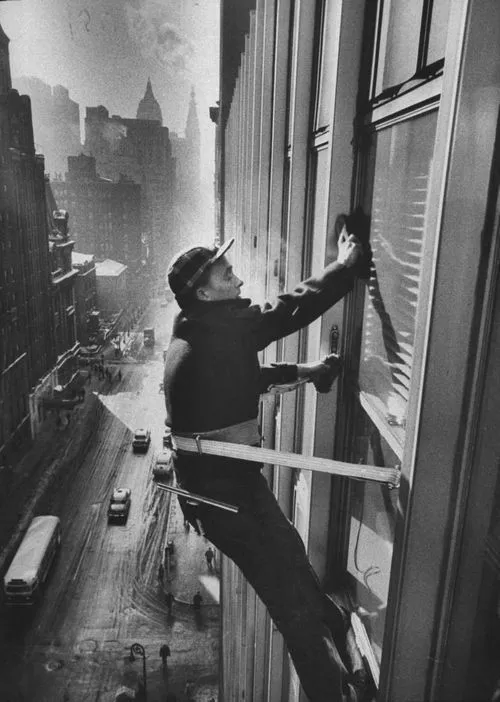PPE Fall Protection in North America
PPE Fall Protection in North America
PPE Fall Protection devices were used in the early 20th Century by many professionals, although they used rope lanyards made of natural fibers, such as manila hemp, and simple body belts with no shock-absorbing properties. Clarence W. Rose–who early in his career was a window washer–became a pioneer in fall protection when he started the Rose Mfg. Co. in 1934 and began producing safety belts and lanyards for window washers. On Nov. 24, 1959, Rose was awarded a patent for an easy-to-use cable connector for safety belts that also had some shock-absorbing properties (U.S. Patent 2,914,139). Listed in the patent was a statement that the connector could, among other things, “be adapted to slip somewhat responsive to a sudden jerk as when the safety rope checks the fall of a wearer and thereby eases the shock to the wearer incurred by checking the fall.”

Madison Avenue Window Cleaner
PPE Fall Protection: shock-absorption major leap forward
Joseph Feldstein, manager of Technical Services at MSA, which purchased the Rose Mfg. Co. in 1996, said the idea of a shock absorber was a major step forward in protecting against the large braking forces generated in arresting falls, especially during Rose’s time.
“If you can imagine, workers with a simple belt and lanyard arrangement that was common up until that point would be exposed to a fall that could not only damage them internally because of the forces exerted to the soft tissues of the abdomen around the belt, but also you could generate such forces that you could separate the lanyard,” he said.
Rose continued to develop his shock-absorbing concept and was awarded several patents for newer and better shock absorbers. Ultimately, his designs influenced the creation of the modern-day shock absorber. Rose also received many other patents related in some way to preventing or protecting workers from falls. An example is the patent for an early “Ladder Climber” harness system (U.S. Patent 2,886,227) that contains two hook lanyards that are both attached to a harness. While ascending or descending, a worker grasps one hook in each hand and secures them over alternating ladder rungs.
Decades later, the industry would see the emergence of locking snap hook connectors and full-body harnesses, both gaining much more acceptance in the 1980s. In 1990, OSHA enacted regulation 1910.66. Craig Firl, product marketing manager in Hardgoods for Capital Safety-USA, said appendix C in this regulation was the key to getting several areas of fall protection technology up to date.
“Even though that particular standard at that time allowed for non-locking-type hooks to be used in a fall protection-type system, they recommended the locking type to be used because they were safer hooks and more compatible,” Firl said.
PPE Fall Protection: more hardware than ever
Feldstein agreed, adding that the acceptance of the locking snap hook led to the creation of a whole new series of connecting anchorage systems: straps, D-rings, and more. “And that’s continued to evolve to its current state, where we now have personalized anchorage connectors for almost every application, whether it’s building construction or general industry,” he said. Even though body belts were still allowed, Feldstein said appendix C acknowledged that OSHA recognized full-body harnesses as a major innovation in fall arrest.
“Belts are still permissible in positioning, but in a fall, you definitely want to be protected by a full-body harness. It distributes the load across your chest and the bony mass of your hip, where your body is most capable of absorbing a blow, and it protects the soft tissue of the abdomen,” Feldstein said.
Two years after 1910.66 arrived, the ANSI committee released standard Z359.1, the key fall protection standard in use today. Most notably, it required the use of full-body harnesses and self-locking snap hooks. Firl said this voluntary compliance standard put pressure on OSHA to recognize that its existing standard needed updating and encouraged the completion of another fall protection standard for the construction industry, Subpart M, in 1995. According to this standard, as of Jan. 1, 1998, the use of body belts and non-locking snap hooks was prohibited.
During the ’80s, Self-Retracting Lanyards (SRLs) gained in development and use. They had been developed in the 1950s for offshore oil production in the North Sea but quickly became a common component in fall protection systems worldwide. Feldstein said SRLs became so valuable because they allowed workers to be protected along a much greater length of travel, increasing productivity without sacrificing safety. He described a scenario for rail car workers:
“Workers could be protected from the ground level and all the way up to the top of the rail car while they were working along the train’s length because the SRL could be mounted mobilely overhead. So that afforded a new type of protection for all types of workers in transportation, everything from rail cars, truck load-outs, and air craft maintenance.”
Regarding fall protection’s future, Firl and Feldstein said they believe comfort will continue to advance. Firl also foresees advances into niche markets with specialized materials and components, similar to the vacuum anchors’ progression into the airline industry for maintenance work on aircraft, whose surfaces can’t be penetrated with traditional-type anchors.
“In the past, a harness was a harness. It didn’t really matter if it was for construction, or utility work, or warehousing, it was a harness,” he said.
“Now, you’re starting to see more specialized gear. . . As an example, in the utility segment, you would see extensively the use of flame-resistant materials . . . because they’re concerned about heat resistance; they’re concerned about being able to resist arc flash and so forth.”
At Hercules SLR we stock MSA, 3M and Honeywell Miller PPE and fall protection products, to provide you with an extensive, high quality range of PPE Fall Protection products. Our in-house experts will advise you on what equipment best suits your project. When it comes time for your yearly inspections and service, our technicians can inspect, repair and certify your gear.
References https://ohsonline.com/Articles/2007/01/01/PPEvolution.aspx?Page=4
——————————————————————————————————————————————
The Hercules Group of Companies encompasses a wide portfolio of products and services across 7 diverse companies.


